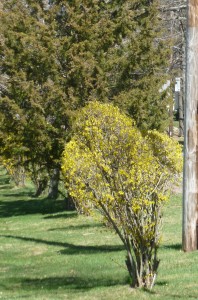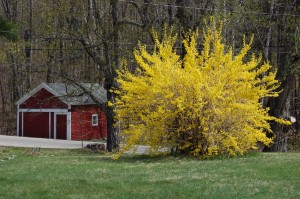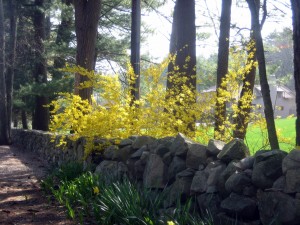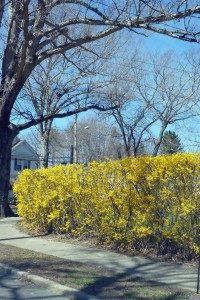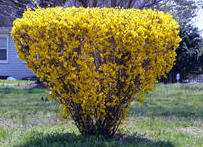“Forsythia is pure joy. There is not an ounce, not a glimmer of sadness or even knowledge in forsythia. Pure, undiluted, untouched joy.” Anne Morrow Lindbergh
I love driving up North Street right now. The forsythia makes a gold trail through the twiggy grey woods, a sprig here, a clump there… a chain of beacons springing to life, from mountain to mountain. (Deleted reference to Pippin and Minis Tirith here…)
What’s not to love about forsythia? Well, a lot, apparently. Plant snobs shudder when they say “forsythia” the way art snobs shudder when they say “Monet.” Too accessible, too easy. Too common.
And it’s true that forsythia can be a pruning problem. You don’t want it to take over the best display space in your yard…
but you also must, MUST resist the urge to prune it half to death.
If you have a lot of space, it’s fine to give forsythia room to explode. On a grey and chilly spring morning in Vermont, what would you say to this?
However, for most of us, forsythia doesn’t rate as a “specimen” plant, because it doesn’t have a lot of interest beyond its bloom period. Here is one of the best situations for forsythia that I have seen: the plant is informally supported by the stone wall, extremely visible from the road, but will blend easily into the woodland in a couple of weeks.
What about forsythia as a hedge? I’m not a huge fan; to me “hedge” means “evergreen.” But forsythias certainly cost less and grow faster than evergreens, and are more resistant to road salts and chemicals. This forsythia hedge is doing a very good job on a tough corner:
This hedge is not as successful; looks like the buds got pruned off.
You need to prune forsythia right after flowering. Reach deep into the bush to prune off the older stems close to the ground. Take out the dead wood and thin the crowded interior branches. Remove extra shoots around the base of the plant that are encroaching where they shouldn’t. You can shorten the longest stems somewhat, if they are too long (you’ll know they are too long because they’ll touch the ground and start to grow roots!).
But whatever you do, don’t do this:
or this…
or this…
Just…no. No. Step aWAY from the pruners.
I think part of growing forsythia is knowing when to let go. You cannot control everything in your life – nor can you control everything in your garden (in fact, there’s very little you can control in either!) – so let forsythia be a moment to let go. Let it do what it wants, which is to arch and spray and sprawl. If you really can’t stand its flowing habit, dig it up and plant an azalea there instead – but don’t throw the forsythia away. (Don’t bother trying; it will grow quite happily on top of your compost heap.) Find a corner for it somewhere, and let the kids cut it down completely every year for bouquets. It’ll come right back!

Forsythia ovata (Early Forsythia, Korean Forsythia, Forsythia Nakai). Not the showiest ever but hardy to Zone 4.
Hey, it’s March. The world is grey. Go out and put a little forsythia in your yard. You don’t have to give it premium space; just plant a sprig on the edge of the woods. Light your beacon!



